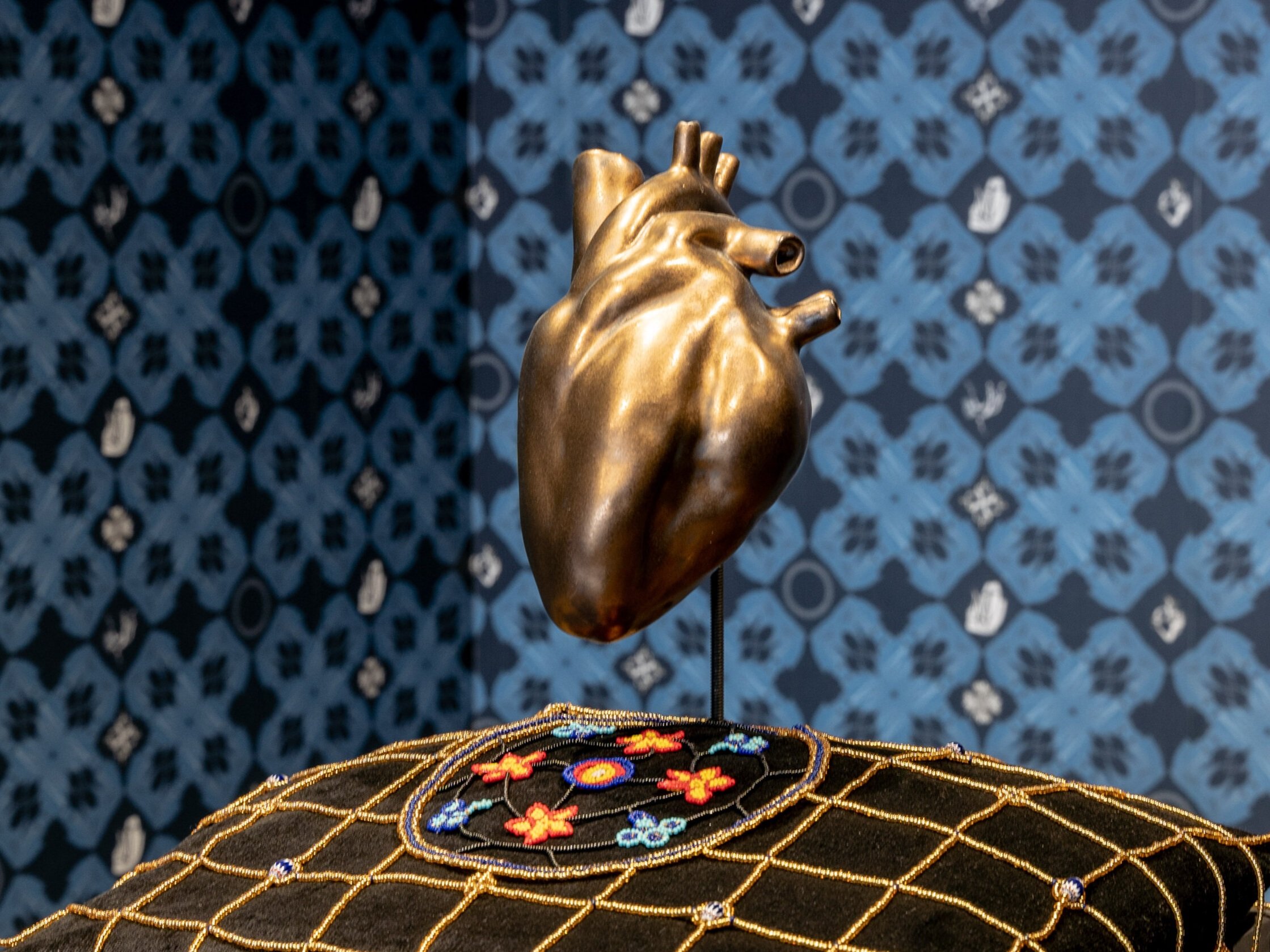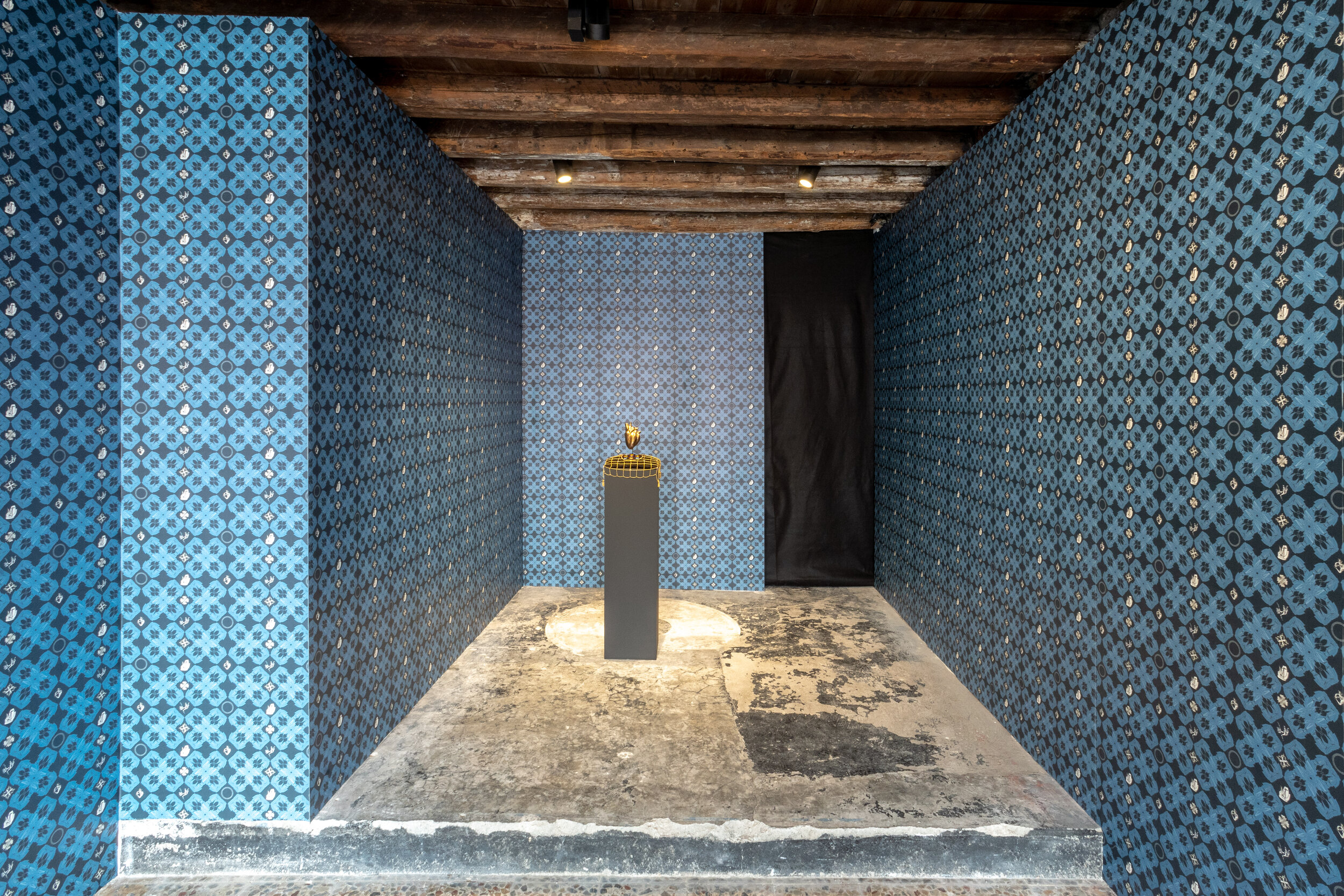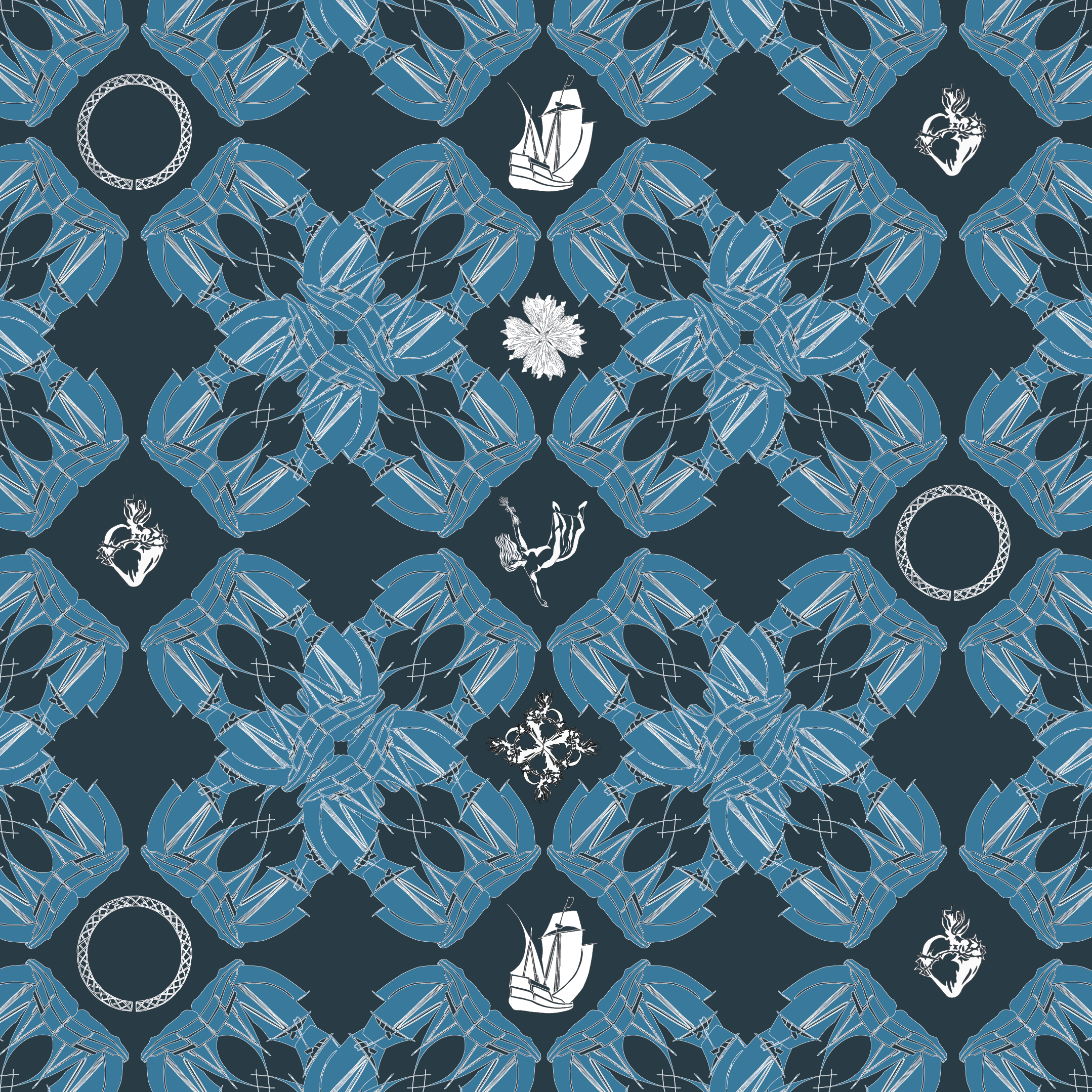Oceanus Procellerum (Volume 0), 2019. Commissioned for Zuecca Projects, Venice Biennale
May 10 — June 30, 2019 10.05.2019
Curated by Dr. Max Carocci
Organized by Alessandro Possati | Director, Zuecca Projects
Marica Denora | Project Manager, Zuecca Projects
The wallpaper room created by Nadia Myre to welcome visitors to Volume 0 consists of three walls and a heart-shaped sculpture woven over with beads. Guided by a soundscape evoking a mythical origin story of the universe beginning with a single sound, the visitor enters a built environment that mixes European and Native elements around which mutually shared stories were variably passed on by American peoples and Europeans each in their own way. Contextual elements such as ships, sections of maps, and other culturally relevant icons displayed on Myre’s design walls furnish the background for the centre piece of her installation: a human heart covered with Murano beads. Presented in much the same way as a man-made object in a Renaissance cabinet of curiosity this three-dimensional piece is emblematic of the relationship that Venice has indirectly had with indigenous North Americans over the centuries. Beads are here a marker or difference and identity simultaneously. Europeans conquered with Venice beads the hearts and imagination of Native peoples who eagerly welcomed this new trade good since the early contact phases. Historically appreciated for their brilliance and versatility, indigenous women created artworks of accomplished skill and beauty. Myre’s glass-covered heart continues in a long-standing artistic tradition that poignantly reminds us of the centrality of women in shaping history. If, as proven by commercial records and economic history, Venetians saw the North American bead trade as a lucrative enterprise, it is equally true that indigenous women’s desire for this merchandise was the incentive for Venetians to produce more, and as a consequence, make more profits. Equally treated as both a commodity and a colonial tool, beads have historically been the means by which European imperial powers established diplomacy and trade with Native North Americans. Used as the soft arm of colonisation, beads are therefore not just trade items, but agents of historical change in a cross-cultural conversation that Myre here invites us to peruse and ponder over.
In her contribution to Volume 0, Myre calls upon deep mythologies and re-examines European claims to a ‘discovery’ of the New World. For Myre, Volume 0 brings to mind an originary sound--a sort of zero-vibration, an uncontained note or utterance--that recalls the many creation myths wherein the world was formed around an unending aural reverberation. Calling on this notion of an unfettered, ever-expanding energy as a point of origin, Nadia Myre’s works in this exhibition juxtapose Native creation stories with European contact history. These works investigate the role that European print media, especially maps, played in imposing a new, colonial origin story on North America’s Indigenous peoples; one that was rooted in a Eurocentric narrative of discovery and ignored existing modes of self-determination and historical record. Jumping off from her practice’s continual interrogation of transcultural mutation, these works focus on critically reversing the gaze of the othering eye through remixing and Indigenizing symbols of control and production of knowledge that formed a legacy of European nation states as the centre of the world.
Depicted in Myre’s damask-patterned wallpaper is a woman falling through a dark, vast expanse to begin human life on earth. To the Haudenosaunee, Sky Woman signifies a matrilineal line of descent which traces the people of Turtle Island to North America. Cradled, framed, or entrapped by images of European ships and mapping motifs, Sky Woman continues her fall to earth, enduring amidst the impending colonial origin narrative of discovery. Here, Myre translates a typical floral damask motif into colonial and indigenous signifiers, whose forms reflect, repeat and oscillate between evocations of growth, nature, violence and destruction, forming a doubled narrative of struggle, resilience, and layered points of origin. Based on the decorative double-sided textile from the Middle East, damask, as a popular luxury wall covering in Renaissance Italy, resonates with thematics of mirroring, cultural transmutation, and power. Through her incorporation of an ornamental circular motif used in Giacomo Gastaldi’s 1556 Map to deliminate Hochelaga (Montreal), Myre uses the decorative and narrative nature of this wallpaper to abstract devices of circumscription and colonial naming of territory in a move to reject settler cartographic and claiming practices towards a consciousness of Indigenous knowledge of land and history. Aptly positioned as the nucleus of the installation is a terracotta sculpture of a human heart--standing in for the hungry heart of capitalism, greed, empires and colonies--covered in an Anishinaabe floral pattern made with Venetian trade beads. Used as ballast in slave/trade ships, beads were an important economic currency and exchanged for both goods and services as well as people. As a call to indigenization--a return to a focus on the environment and relational ways of knowing--the wounded heart, blanketed with beads, reminds us to centre with respect and love on all our relations. As a haunting story of the start of the world from a zero-point that precedes humanity, life, and form alike, the soundscape in Myre’s installation is a representation of the mythic original sonic vibration--rethinking the ways beginnings are identified, inscribed, written, and read. Points of origin are chosen; they do not indicate an end to nothingness, but only an inability to read what previously existed. Engaging creation stories are powerful tools of self-determination, cultural definition, and expression of value,
Volume 0 asks us to question how and by whom zero-markers are identified and how ideas of origins can shape our shared future.




